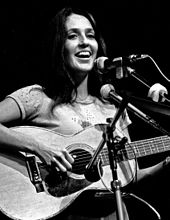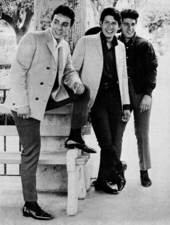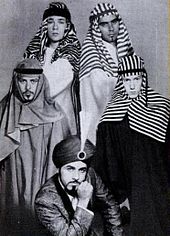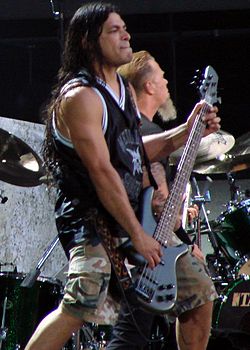Chicano rock
This article may be in need of reorganization to comply with Wikipedia's layout guidelines. (January 2025) |
| Part of a series on |
| Chicanos and Mexican Americans |
|---|
 |

Chicano rock, also called chicano fusion, is
Overview
There are three basic styles of Chicano rock.

1) The earliest Chicano rock emerged as a distinctive style of
A tradition of 60s Chicano rock emerges from these origins, following a devotion to the original
2) The second style of 70s Chicano rock is more open to
3) A third style is the 80s Latin rock, Latin R&B by
History

In places such as
Don Tosti's Pachuco Boogie, recorded in 1948, was the first Chicano million-selling record,[7] a swing tune featuring Spanish lyrics, using hipster slang called Calo. Lalo Guerrero arrived in Los Angeles in the late 1930s and found that L.A is "bursting with ambition". Lalo and his friend captured their spirit in music by mixing swing and boogie woogie in a cross-cultural, dialog between African American, Anglo, and Mexican American influences.[8]
The 1950s brought rhythm and blues and the roots of rock 'n' roll. Mexican American were among first to catch the beat and introduced a Latin flair to early rock music.[8]

Chicano rock 'n' roll star
The 1958 hit song "
In the early to mid-1960s, the American audience was probably more open to Latin sounds than even today because of the popularity of
In the 60s there was an explosion of Chicano rock bands in East Los Angeles and Texas.


The
In the late 1960s and 1970s, when civil rights and the

The trend of Chicano rock mirrored what was happening on college campuses as well. The rise of Chicano Studies departments, which offered courses in Chicano literature, politics and culture, affected college students and musicians tremendously. Musicians rebels against the "old world" and adopt the Mexican and Latin American styles in their own music.[8]

Along with visual artists, activists, and audiences, the musicians of the East Los Angeles chicano rock scene form an emergent cultural movement that speaks powerfully to present conditions. The chicano rock scene of East Los Angeles serves as a form of unity for radical Chicanos who wish to bring forth a call to action and a site for resistance through their art. By claiming the musical style of the "old world", Chicanos are reclaiming their indigenous identity and undoing Spanish colonialism.
The Eastside scene's story of formation, the diversity of its origins, and its commitment to political activism and coalition building illuminate the relations between culture and politics in the present. The musical practices of the East L.A. scene bring to the discussion the dislocations and displacements of people of color in urban California, but they also reflect the emergence of new forms of resistance that find counterhegemonic possibilities within contradictions. [20]
Linda Ronstadt is a versatile singer who traversed multiple genres. She gained national hits such as "You're No Good" (1975), "It's So Easy", "Blue Bayou" (1977), "Back in the USA" (1978), and "Hurt So Bad" (1980) in the 1970s and '80s. Ronstadt was nurtured by her Mexican American family whose musical roots run deep in the Mexican border region of Tucson, Arizona. Ronstadt holds dear the memory of childhood serenades by "The Father of Chicano Rock," Lalo Guerrero, a close family friend. Ronstadt's great-aunt Luisa Espinel gained international popularity interpreting Spanish and Mexican song and dance in the 1930s. Among the most popular female pop singers, Ronstadt is one of the most influential Chicana musicians ever, as evident in her extensive discography and four-decades long career.[21]
Chicano Rock 1980s

In 1980s, Tierra gained TOP 40 hit "Together", and Cheech and Chong recorded "Born In East LA".

In the mid-1980s Chicano teen rock band
Subsequently, groups like 90s band Ozomatli and Quetzal had led the new wave of Latin Rock groups that fuse multiple musical genres.
Ozomatli mixes rock,
Quetzal, the band from the barrios of East Los Angeles has been creating Latin folk and roots-rock music for over a decade. With the successful tours and concerts alongside Los Lobos, Ozomatli, Taj Mahal and Michelle Shocked, Quetzal has played intimate clubs and large arenas alike. The band combines rock, Afro-Cuban, country blues, and jazz elements to support the wide-ranging, bilingual vocals of Martha González. The retro-futuristic mix has garnered praise from critics including the LA Times and Los Lobos. Quetzal simultaneously forges a sound that makes you dance and contemplate change.[26]
Robert Lopez AKA El Vez started operating an art gallery called "La Luz de Jesus" and created a show dedicated to Elvis. Since Lopez's impersonator did not meet his expectation El Vez was created. El Vez's first performance was in Memphis, Tennessee on August 16, 1989. Lopez started making karaoke tapes while running his gallery. While not including "sacred" topics directly, his goal is to blur the line between what is sacred and profane allowing him to have wide age range in his audience. He has been releasing albums since 1994 continuing to use satire and humor in his songs to express revolutionary views. As his lyrics are historical, some teachers and professors use his music to teach history and Mexican American Culture.[27]
Chicano/Latino Punk

Chicano punk is a branch of Chicano rock with bands like The Zeros, The Stains, The Plugz, The Bags, Thee Undertakers, Nervous Gender, The Brat, The Gun Club, Los Illegals, Los Angelinos, Felix and the Katz, Odd Squad, Union 13, and The Cruzados coming out of the punk scene in Los Angeles. The rock band ? and the Mysterians, made up of Hispanic American musicians from Bay City and Saginaw, Michigan, was the first band to be described as "punk rock." The term punk rock was reportedly coined in 1971 by rock critic Dave Marsh in a review of their show for Creem magazine.[28] Recent Chicano punk bands include Rayos X,
In 1992 Mia Zapata and her punk rock group The Gits released Frenching the Bully, their first album, on C/Z Records. The group members met one another and formed the band in Yellow Springs, Ohio during the mid-1980s. Their music quickly became popular throughout the area and on the Antioch College campus. Band member Moriarty describes punk rock as a combination of emotion, temperament, rage and music.[citation needed] The Gits moved from Ohio to San Francisco and finally to Seattle, but not because of the up-and-coming music scene. Moriarty explains that "the idea was to just go up and pour your guts out" and to play their music and express their emotion. The group dissolved after Mia Zapata was murdered on July 7, 1993 by Jesus Mezquia. The remaining members went on to team up with Joan Jett to issue the album Zapata's death had interrupted. Proceeds from the album, titled Evil Stig (Gits Live spelled backwards) went to fund an investigator into Zapata's death, which had become a cold case.[29][30]


Many
Chicano Rock, 1990s–present
Many popular Chicano and Chicano-led rock bands began to emerge during the mid and late 90s such as
Modern age Chicana
In the 2020s, a new generation of Chicano rock artists, influenced by bands such as
Cultural politics of Chicano/a rock

Zacharias Manuel de la Rocha is an activist is best known as the vocalist and lyricist of rock band Rage Against the Machine. Rage Against the Machine songs express revolutionary political views. As of 2010, they had sold over 16 million records worldwide.[35] Chicano rock music is being led by a wave of socially and politically active Latin-fusion bands that emerged and gained popularity in the 1990s such as Aztlan Underground, Ozomatli, Lysa Flores, Quinto Sol and more. Their music in general pulls from other genres (soul, samba, reggae, and rap) and utilizes multilingual lyrics (in Spanish, English and Nahuatl) and takes themes like urban exile, indigenous identity and multiracial unity and layers them in order to put into the spotlight important social issues. These artists in particular have been exceptionally successful due to the millions of Latinos in Los Angeles, California that are bilingual/bicultural. One of the larger purposes of the music is to draw attention to "present conditions of oppression and disenfranchisement" in the East L.A. scene, and to provide a form of political possibility to those who are less powerful (financially, socially, etc.).[36]
The Alacranes' frontman, Ramón "Chunky" Sánchez, once said that Chicano rock lies "somewhere between Pedro Infante and the Rolling Stones." This categorization, or lack-thereof, by Sánchez demonstrates that Chicano rock might be characterized by an identity rather than a musical style.[37]
Chicano/a rock as a global phenomenon

Chicano rock's origins in diverse places like Los Angeles and San Francisco requires us to consider the many cultures that went into its creation. Shared experiences of discrimination have led black and Latinx communities to build what George Lipsitz called "a 'historical bloc' of oppositional groups united in ideas and intentions if not experience."[38] A shared experience in America amongst members of Lipsitz's "historical bloc" led to cultural, and musical, fusion that transcends national borders. Jesus Velo of 1970s Chicano punk band, Los Illegals, has said "We [had] no choice but to just absorb each other's rhythms and patterns."[39] Through this fusion, international musical styles mixed with American rock to create something novel and multicultural. Mexican-American artists' music in this era has been labelled 'Chicano rock.' It's undeniable that Chicano rock helped create a distinct Mexican-American identity, but this includes elements of other Latin American nations.[39]
Additionally, Latin American nations' musical styles were not developed in isolation. Loza writes, "Latin America must be considered a cultural entity much like that of other continental areas––for example, the United States, Europe and East Asia––where intercultural expression ultimately signifies various national identities and 'characters'."[40] Latin American nations are built on a mix of indigenous, colonist, and African peoples, and their music reflects contributions from these different cultures.
See also
- Tex-Mex music
- Brown-eyed soul
- G Funk
- Chicano rap
- El Chicano
- Boogaloo
References
- ^ "Rock Chicano – American Sabor" (in Spanish). Archived from the original on March 2, 2016.
- ^ Unterberger, Ritchie. "Biography". AllMusic. Retrieved May 27, 2024.
- ^ "War| Biography & History". AllMusic. Retrieved August 22, 2020.
- ^ Swanson, Dave (May 5, 2023). "Examining Mexican-Americans' Contributions to Classic Rock History". Ultimate Classic Rock.
- ^ "Rocky Paddila". All music. Retrieved February 24, 2023.
- ^ "Rosie and the Originals". San Diego Reader. Retrieved May 20, 2024.
- ^ "Don Tosti, 81; Inspired Latin Music Craze". August 4, 2004. Retrieved March 18, 2021.
- ^ a b c d Waldman, Tom. "The Story of Chicano Rock & Roll Part 2 of 2 – NoHoArtsDistrict.com". Retrieved October 12, 2017.
- ^ "Ritchie Valens". Biography.com. Retrieved October 12, 2017.
- ^ "A toast to 'Tequila!' singer – Press-Telegram". Archived from the original on September 27, 2007.
- ^ "Trini Lopez Biography". IMDb.com. Retrieved July 30, 2020.
- ^ "The Songs Remain the Same". Texas Monthly. March 1, 2007.
- ^ "Barry Rillera". rockwest.tv.
- ^ Epting, Chris (May 6, 2014). "In the Pipeline: Barry Rillera is living rock history". Archived from the original on June 24, 2019.
- ^ "Chicano Rock!|The Sounds of East Los Angeles". PBS Programs - PBS. Archived from the original on November 1, 2012.
- ^ "Fifty years later, Question Mark and the Mysterians as mysterious as ever". MLive.com. Retrieved October 14, 2018.
- ISBN 9781439900918. Retrieved October 12, 2017 – via Google Books.
- ^ "Official website". Cheech & Chong. Retrieved March 20, 2021.
- JSTOR 1354360.
- S2CID 143471138. Retrieved October 12, 2017 – via Project MUSE.
- ^ "Linda Ronstadt – American Sabor". americansabor.org. Archived from the original on October 12, 2017. Retrieved October 12, 2017.
- ^ Guerrero, Mark. "Maldita Vecindad: Bridging Mexican and Chicano Rock". markguerrero.com. Retrieved October 12, 2017.
- ^ Salas, Abel. "Chicano rock-gods". Ritmo Beat Magazine. Photographer, Chris Jurgenson. Renegade World Music. Archived from the original on February 18, 2012.
- ^ "David Hasselhoff Introducing Renegade at 30 Million Platinum Sales Award event". November 19, 2008. Archived from the original on December 11, 2021 – via Youtube.com.
- ^ "Ozomatli". Sound Tracks. Iowa PBS. December 10, 2010.
- ^ "An Evening with Legendary Chicano Rock Band QUETZAL". June 2, 2014.
- ^ Larson, Susan (1997). Rock and Revolution: An Interview with El Vez, the Mexican Elvis. pp. 141–152.
{{cite book}}:|work=ignored (help) - ^ "The revolution that saved rock". CNN. November 13, 2003. Retrieved April 28, 2010.
- ^ Whitney Seibold (October 8, 2016). "The Time Rocker Joan Jett Helped Apprehend a Killer". Blumhouse.com.
- )
- ISBN 9780814736623.
- ^ a b Seggel, Heather. Violence Girl: East L.A. Rage to Hollywood Stage, a Chicana Punk Story. p. 54.
{{cite book}}:|work=ignored (help) - ^ O, Kelly. "Chicana Punk Four Reasons You Should Know Alice Bag". The Stranger.
- ^ Freeman, Phil. These Latinas May Rock, but Girl in a Coma Isn't Making Latin Rock.
{{cite book}}:|work=ignored (help) - ^ Berdini, Valerio (June 9, 2010). "live on 35mm.Berdini,Valerio". Archived from the original on July 18, 2011.
- S2CID 143471138.
Los Angeles and the Future of Urban Cultures
- ^ Azcona, Stevan Cesar (2008). Movements in Chicano music: Performing culture, performing politics, 1965–1979. p. 3. ProQuest 304482559.
- JSTOR 1354360.
- ^ ISBN 9780252032431.
- ISBN 9780895511676.
Further reading
- ISBN 0-252-06288-4.
- Monsalvo, C. Sergio (1989). La canción del inmigrante: de Aztlán a Los Lobos (in Spanish). México, D.F.: Tinta Negra. ISBN 968-6336-01-X.
- Reyes, David; Waldman, Tom (1998). Land of a Thousand Dances: Chicano rock 'n' roll from Southern California. Albuquerque: University of New Mexico Press. ISBN 0-8263-1929-7.
External links
- "articles on Chicano Rock". Guerrero, Mark. 2008. Retrieved July 8, 2008.
